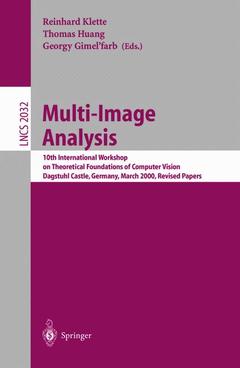Description
Multi-Image Analysis, 2001
10th International Workshop on Theoretical Foundations of Computer Vision Dagstuhl Castle, Germany, March 12-17, 2000 Revised Papers
Lecture Notes in Computer Science Series, Vol. 2032
Coordinators: Klette Reinhard, Huang Thomas, Gimel'farb Georgy
Language: English
Publication date: 05-2001
296 p. · 15.5x23.5 cm · Paperback
296 p. · 15.5x23.5 cm · Paperback
Description
/li>Contents
/li>Comment
/li>
This book constitutes the thoroughly refereed post-proceedings of the 10th International Workshop on Theoretical Foundations of Computer Vision, held at Dagstuhl Castle, Germany, in March 2000.
The 20 revised full papers presented have been through two rounds of reviewing, selection, and revision and give a representative assessment of the foundational issues in multiple-image processing. The papers are organized in topical sections on 3D data acquisition and sensor design, multi-image analysis, data fusion in 3D scene description, and applied 3D vision and virtual reality.
The 20 revised full papers presented have been through two rounds of reviewing, selection, and revision and give a representative assessment of the foundational issues in multiple-image processing. The papers are organized in topical sections on 3D data acquisition and sensor design, multi-image analysis, data fusion in 3D scene description, and applied 3D vision and virtual reality.
3D Data Acquisition and Sensor Design.- Modelling and Removing Radial and Tangential Distortions in Spherical Lenses.- Geometry of Eye Design: Biology and Technology.- Epipolar Geometry in Polycentric Panoramas.- Image-Based Rendering from Uncalibrated Lightfields with Scalable Geometry.- Recent Progress in Digital Photogrammetric Stereo Cameras and Data Evaluation.- Classification and Characterization of Image Acquisition for 3D Scene Visualization and Reconstruction Applications.- Multi-Image Analysis.- Structure Multivector for Local Analysis of Images.- Matching Multiple Views by the Least Square Correlation.- Gabor Wavelet Networks for Object Representation.- Multi-valued Images and Their Separation.- Towards Segmentation from Multiple Cues: Symmetry and Color.- Pose Estimation Using Geometric Constraints.- Data Fusion in 3D Scene Description.- The Fusion of Image and Range Flow.- Knowledge-Based Concepts for the Fusion of Multisensor and Multitemporal Aerial Images.- Ellipsoidal Bias in Learning Appearance-Based Recognition Functions.- Scene Change Detection Based on Audio-Visual Analysis and Interaction.- Applied 3D Vision and Virtual Reality.- Implicit 3D Approach to Image Generation: Object-Based Visual Effects by Linear Processing of Multiple Differently Focused Images.- Content-Based Image Retrieval Using Regional Representation.- Integration of Photometric Stereo and Shape from Occluding Contours by Fusing Orientation and Depth Data.- Visual Sign Language Recognition.
Includes supplementary material: sn.pub/extras
© 2024 LAVOISIER S.A.S.




